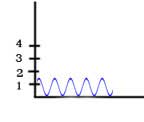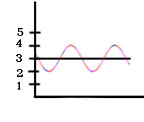
The Amplitude is .6 |

The Amplitude is 1 |
Here is the definition of wave amplitude that scientists use!
- Amplitude is a measurement of the top (or bottom) half of the wave.
- What does it mean?
- If there were no light wave at all, these graphs would be flat, like a string before it is
plucked. Call that the zero position*. When you pluck a string, you pull it away from zero position by a certain
distance, called the amplitude, using a certain amount of energy. Afterwards, as the string vibrates, its wave
peaks go back to (but not beyond) that original size, until the wave starts to lose energy (die down). That distance
from the zero position to the top of every wave peak always tells how much energy is left in the wave. In the same
way, the amplitude of a light wave is also a measure of how much energy the wave carries.
- Why only half?
- Scientists like to call the middle point zero, so that the bottom half of the wave has a
negative value, like -0.7 or -1. But energy is something positive, so the measure from zero to the peak, which
is always positive, is what we use. The bottom half shows the same amount of energy, and the distance is the same.
Since we always use the distance from zero to the peak, we can always compare amplitudes of different waves without
getting confused about plus or minus.
* A scientist would call it "equilibrium," which means a state of balance.



